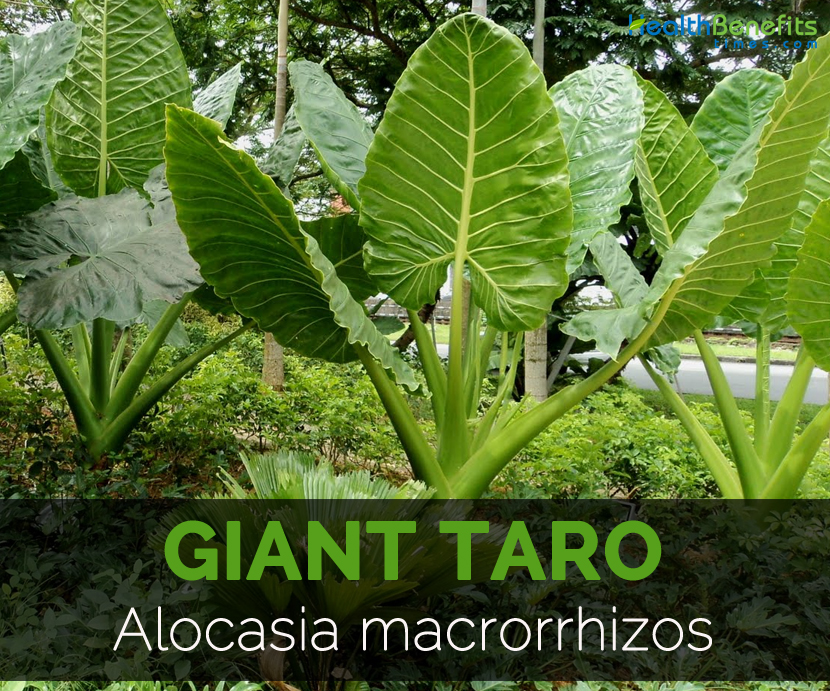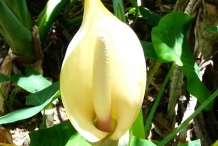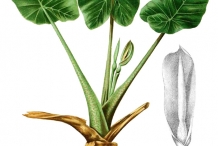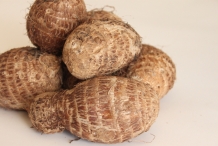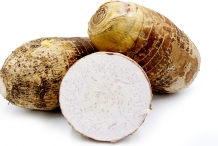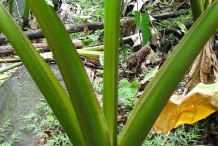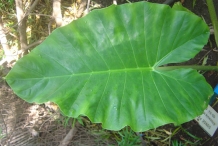It is widely cultivated in the subtropical and tropical regions. It was originated from India, Southeast Asia and Sri Lanka and also spread to Oceania and Asian tropical countries.The plant is found in the humid moist, medium and low elevation valleys where it got naturalized along the stream banks. Today it is available throughout tropics. The leaves and stem are widely used as vegetables.
Plant
Giant taro is a coarse, erect, monoecious, rhizomatous and evergreen plant which grows to about 5 m high with large, sagittate, rosette leaves measuring upto 0.9-1.8 m long and 0.6-1.2 m wide. The leaves are glossy in medium green color. The fruit is spathe, oblong top ellipsoid, green and 8 cm long. Each fruit possess several, pale brown seeds with 4 mm as a diameter. It has upright, erect, elongated, woody stems of 1-1.2 m long and 25 cm in diameter. It prefers tropical, subtropical climates and well-drained soil.
Nutritional Value
100 grams of raw Giant taro serves 70 grams of water, 100 calories, 2.2 grams of protein, 0.1 grams of lipid fat, 23 grams of carbohydrate and 1.9 grams of dietary fiber. The same amount cover minerals such as 38 mg of calcium, 0.8 mg of iron, 52 mg of magnesium, 267 mg of potassium, 30 mg of sodium and 1.6 mg of zinc. It provides the vitamins such as 0.02 mg of Vitamin B1, 0.02 mg of Vitamin B2, 17 mg of Vitamin C and 2 mg of Vitamin E.
Health Benefits of Giant Taro
Giant taro provides various benefits to the health. It is rich in Vitamin C, carbohydrate, zinc, vitamin E, magnesium and iron which is essential to maintain the health.
- Prevent scurvy
Scurvy is the health condition which is caused due to the deficiency of Vitamin C in the body. The symptoms occur due to the weakening of bones, blood vessels and connective tissues that involve collagen. Vitamin C is an antioxidant which is essential for the collagen production. (1)
- Eliminates free radicals
Vitamin C is an antioxidant which prevents the damage caused due to the free radicals, pollutants and toxic chemicals. The buildup of free radicals leads to the health ailments such as heart disease, arthritis and cancer. Free radicals build up during the breaking down of food or exposed to tobacco, smoke and radiation. (2)
- Treats acne
Zinc helps to eradicate the acne from the skin. It helps to regulate the testosterone levels which play a vital role in the formation of acne. It helps to normalize the skin oils and enhance the skin health. Zinc promotes the count of white blood cells and lowers the risk of infection. Zinc also helps to lower the scars which are left by the acne. (3)
- Balance hormones
Zinc has positive effect on fertility and hormonal health because it plays a vital role in the production of hormones such as increase in testosterone naturally. Zinc effect the hormones of female sex and involves in the release and creation of eggs from the ovaries.
Zinc is essential for the progesterone and estrogen production which supports the reproductive health. The excessive presence or deficiency of estrogens will create the problem with mood swings, menstruation, infertility and early menopause. (4)
- Vision
Vitamin E lowers the chances of macular degeneration which is an age related eye disease that is the cause for blindness. It should be consumed with beta carotene, vitamin C and zinc. The study shows that high intake of Vitamin A and Vitamin E improves the vision and healing in the people who have undergone through laser eye surgery. (5)
- Treats insomnia
Magnesium can helps to get a sound sleep. Those who have low nutrient consumption and low absorption of nutrients are at high chances of getting insomnia. The study shows that the people with magnesium supplements have increase in sleep time, high amount of melatonin and low level of cortisol which is related to stress. Magnesium helps to lower the symptoms of insomnia effectively, enhance sleep efficiency, sleep onset and sleep time. (6)
- Prevent heart ailments
Magnesium prevents the irregular heartbeats, heart damage and muscle stress. It soothes the nerves and mediates the digestive processes which prevent the ailments such as indigestion, vomiting, cramps, flatulence, abdominal pain and constipation. The deficiency of magnesium increases the chances of fatal heart disease. (7)
- Prevent cramps
Magnesium helps to treat backaches by relaxing kidney stress, back muscles and muscular tension. It assists in the calcium absorption that speeds up the healing of bones. The deficiency of magnesium results in the symptoms such as general fatigue and leg cramps. The adequate intake of magnesium helps to cure the problems of chronic leg cramps. (8)
- Brain health
Iron aids the oxygen supply in the blood. About 20% of the oxygen is used by the brain so iron is related to the function and health of brain. The adequate blood flow in the brain enhances the cognition and creates the neural pathways which help to prevent the cognitive ailments such as Alzheimer’s disease and dementia. (9)
- Formation of hemoglobin
Iron is essential for the hemoglobin formation and it also provides the dark red shade to the blood. It transports the oxygen up to the body cells. As human beings lose the blood in both external and internal injuries, extra hemoglobin is very important. Women lose blood during menstruation every month due to which they have high chances of getting anemia than men. (10) (11)
Traditional uses
- In India, Southeast Asia, Bangladesh and Papua New Guinea, it is used in folkloric medicine.
- In Malaysia, the juice is applied to provide relief from stings.
- The sap of petioles is used to treat cough.
- In Java, the roots and leaves are applied to relieve the joint pains.
- In Papua New Guinea, the external use of sap helps to treat headache.
- In India, corm is used to cure scorpion stings, abdomen disease, spleen, rheumatism and gout.
- The poultice made from fresh leaves is applied to eliminate pain of varicose veins and enhance blood circulation.
- In Indonesia, the tuber is used to cure fever, influenza, headache, malaria, diarrhea, typhoid, pulmonary tuberculosis, rheumatism, ringworms, abscesses, snakes, insect and dog bites.
- In Bangladesh, this herb is used to treat diabetes; juice extracted from stem is applied to eliminate oedema, pain as well as bleeding from wounds and cuts.
- The plant is used as an aid for pus in ears, constipation and jaundice.
- In China, Giant taro is used to treat joint disorders, headache, flu complication, chronic bronchitis, bleeding haemorrhoids and appendicitis.
- In Hawaii, the tuber is used to cure acute abdominal pain and burns.
- The leaves help to enhance eye sight and prevent iron deficiency.
- Tuber is used to cure rheumatism, anasarca and leprocy.
- The petioles are used as an aid for toothache and its juice is useful for earache, cough and stomachache.
- The rootstock is used as diuretic, mild laxative for inflammations and abdomen & spleen diseases.
- The leaf is considered to possess an astringent, antitumor and styptic property.
- A decoction made from leaf and stem if used in a bath helps to cure skin such as itching and burns.
- A poultice made from leaves helps to improve circulation, reduce pain and prevent bursting.
- Decoction made from rhizomes is useful for vomiting and abdominal pains.
- In Vietnam, this plant is used to treat eczema, inflammation and abscesses.
Precautions
- Uncooked or semi cooked taro cause itchiness in the throat and mouth. Therefore It must be cooked well before consume.
- The swollen stem tubers, cormels and corms are are poisonous. If it consume raw as it possess Raphide Oxalic Acid crystals that could lead the swelling of mouth and throat fatally.
How to Eat
- In Pacific islands, the tubers are baked, roasted or boiled.
- In Southeastern Asia, the tuber is chopped into pieces and consumed as a vegetable after being cooked in curries or stews.
- The corms and leaves are also cooked as food.
- The corms are roasted, baked and boiled.
- Giant taro is used as a source of starch or flour.
- The swollen stem, corms, tubers and cormels are boiled prolonged or roasted before processing as a food.
- The corms, cormels, tubers are chopped into pieces and boiled in water then in coconut milk or broth fried in kenari or coconut oil.
- In New Guinea (Papua), the leaves are consumed by preparing in coconut milk.
- The leaves are fried with onions, chilli, garlic, etc.
References:
http://journals.tubitak.gov.tr/biology/issues/biy-12-36-5/biy-36-5-11-1112-11.pdf
http://www.stuartxchange.com/Biga.html
http://www.cabi.org/isc/datasheet/4220
file:///C:/Users/drchi_000/Downloads/24352-87550-1-PB.pdf
Comments
| Giant Taro Quick Facts | |
|---|---|
| Name: | Giant Taro |
| Scientific Name: | Alocasia macrorrhizos |
| Origin | Native to tropical Asia. It was originated from India, Southeast Asia and Sri Lanka and also spread to Oceania and Asian tropical countries. |
| Colors | Glossy, medium green (Leaves) |
| Shapes | Large, sagittate, rosette, flatten blades; Length: 0.9-1.8 m; Width: 0.6-1.2 m (Leaves) |
| Calories | 100 Kcal./cup |
| Major nutrients | Vitamin C (18.89%) Carbohydrate (17.69%) Zinc (14.55%) Vitamin E (13.33%) Magnesium (12.38%) |
| Health benefits | Prevent scurvy, Eliminates free radicals, Treats acne, Balance hormones, Vision |
| More facts about Giant Taro | |
| Rank | Scientific Name & (Common Name) |
|---|---|
| Kingdom | Plantae (Plants) |
| Subkingdom | Tracheobionta (Vascular plants) |
| Superdivision | Spermatophyta (Seed plants) |
| Division | Magnoliophyta (Flowering plants) |
| Class | Liliopsida (Monocotyledons) |
| Subclass | Arecidae |
| Order | Arales |
| Family | Araceae (Arum family) |
| Genus | Alocasia (Schott) G. Don (Taro) |
| Species | Alocasia macrorrhizos (L.) G. Don (Giant taro) |
| Synonyms |
|


